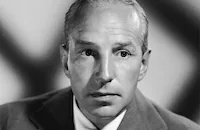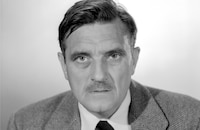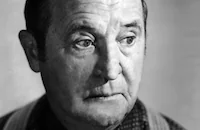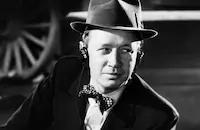Lady in the Lake

Brief Synopsis
Cast & Crew
Robert Montgomery
Robert Montgomery
Audrey Totter
Lloyd Nolan
Tom Tully
Leon Ames
Film Details
Technical Specs

Synopsis
In Los Angeles, private detective Philip Marlowe recalls the day he became involved in the infamous "lady in the lake" murder case: Frustrated over the low pay of detective work, Marlowe writes a short crime story which he submits to Kingsby Publications. While meeting with magazine editor Adrienne Fromsett to discuss the publication of his story, Marlowe learns that she has summoned him to the Kingsby offices under false pretenses. Adrienne is not interested in Marlowe's story, and instead asks him to help her find Chrystal Kingsby, the estranged wife of Derace Kingsby, the magazine's publisher. When Adrienne tells Marlowe that Kingsby's wife is a liar and a cheat and that Kingsby wants a divorce, Marlowe accuses Adrienne of trying to break up Kingsby's marriage so that she can marry him herself. Marlowe is intrigued by Adrienne's desperation, and because he is also attracted to her, he agrees to work for her. After learning that Chrystal was last seen with a playboy named Chris Lavery, Marlowe begins his investigation with a visit to Lavery's home in Bay City. Lavery invites Marlowe into his home, and calmly answers his questions before abruptly knocking the detective unconscious. Hours later, Marlowe regains consciousness in a jail cell and is taken to see Bay City police detectives Lieutenant DeGarmot and Captain Fergus K. Kane. Kane warns Marlowe not to start trouble in his district and then releases him. Marlowe later reports to Adrienne, who advises him to take his investigation to Little Fawn Lake, where the Kingsbys have a resort home and where Chrystal was last seen. Before Marlowe leaves Adrienne's office for the lake, a reporter arrives with news that Bill Chess, the caretaker at Kingsby's resort, has been arrested for the murder of his wife Muriel, whose body was found in the lake. Adrienne tells Marlowe that she fears that Chrystal may actually be the murderer as she hated Muriel and insists Marlowe go to Little Fawn Lake. Upon returning from the resort, Marlowe tells Adrienne that the body found in the lake had been there for nearly a month and that he also discovered that Muriel used the name "Mildred Havelend," and that she married the caretaker because she was being pursued by someone and needed a place to hide. Marlowe also reports that Muriel and Chrystal had a fight over a man and that he, Marlowe, had found an anklet inscribed with the words, "to Mildred from Chris." Suspecting that Lavery is tied to the disappearance of both Muriel and Chrystal, Marlowe pays another visit to Lavery's house. There he finds the door unlocked and meets a confused woman wielding a pistol, who introduces herself as Mrs. Falbrook, Lavery's landlady. Mrs. Falbrook says Lavery is not in the house and that she found the gun on the landing and gives it to Marlowe before departing. The detective then investigates upstairs and in the bedroom discovers a handkerchief with the initials "A. F." on it and in the bathroom he finds Lavery's bullet-ridden body in the shower. Believing that either Adrienne or Kingsby is responsible for Lavery's murder, Marlowe interrupts a Christmas party at Kingsby's office and shows Adrienne the gun, but she appears genuinely stunned over Lavery's death. When Marlowe brings Kingsby up to date on his activities, the publisher expresses shock that Adrienne has been trying to sabotage his marriage and tells her she misunderstood his interest in her. Though she confesses that she was after Kingsby's money, Adrienne denies Marlowe's accusation that she murdered for it or that she was involved with Lavery. Adrienne then angrily fires Marlowe, but Kingsby immediately hires him to find Chrystal and help him protect her from false murder charges. Marlowe goes back to Bay City to return the gun to Lavery's and finds Kane and DeGarmot there. When left alone with DeGarmot, Marlowe suggests the policeman knows Muriel well and that he could be the man from whom she was hiding. DeGarmot scuffles with Marlowe and the police try unsuccessfully to have the detective charged with Lavery's murder. Later, Marlowe gets information from a newspaper editor contact that Muriel, a nurse, was mixed up in the mysterious death of Florence Elmore, the wife of the doctor for whom she worked in Bay City. After questioning Florence's frightened parents and learning a policeman is involved, Marlowe begins to suspect that it is Chrystal, not Muriel, whose body was found in the lake and that Muriel is the murderer and DeGarmot is covering up for her. Before he can investigate further he is attacked, but before passing out, he phones Adrienne for help and wakes up in her apartment. Adrienne admits she has fallen in love with Marlowe and they spend the day together. Later, Kingsby arrives, looking for Marlowe to tell him that he has received a telegram from Chrystal, indicating that she is in Bay City and in need of money. Marlowe suspects a trap and volunteers to deliver the money to her himself. After leaving a trail for the police to follow, Marlowe discovers that the woman who is trying to collect money from Kingsby is the same woman who introduced herself to him as Mrs. Falbrook. Marlowe realizes that Mrs. Falbrook is really Muriel and that his suspicion that she killed Chrystal and Lavery to cover up her murder of Florence is correct. When Muriel threatens Marlowe with a gun, DeGarmot arrives unexpectedly and threatens to kill both of them and frame them for all the murders. DeGarmot reveals he has been covering up for Muriel who professed romantic interest in him to get him to cover up Florence's murder. Furious at her deceit, Degarmot shoots Muriel, but as he is about to kill Marlowe, he is shot dead by Kane. With the murder case solved, Marlowe resumes his romance with Adrienne.

Director

Robert Montgomery
Cast

Robert Montgomery

Audrey Totter

Lloyd Nolan

Tom Tully

Leon Ames
Jayne Meadows
Dick Simmons

Morris Ankrum
Lila Leeds
William Roberts
Kathleen Lockhart
Ellay Mort
Ellen Ross

Cy Kendall

Ralph Dunn
Wheaton Chambers

Frank Orth
William Mckeever Riley
Robert Williams
Fred E. Sherman
Jack Davis

John Gallaudet
Tom Murray
George Magrill
Budd Fine
John Webb Dillon
Billy Newell

Eddie Acuff
Nina Ross
Charles Bradstreet
George Travell
William O'leary
Bert Moorehouse
Florence Stephens
Sandra Morgan
Fred Santley
Laura Treadwell
Kay Wiley
Frank Dae
David Cavendish
James Nolan
Sherry Hall
Ann Lawrence
Roger Cole
Crew
Preston Ames
Robert Barnes
Jack Dawn
Steve Fisher
Cedric Gibbons
A. Arnold Gillespie
Maurice Goldman
Sydney Guilaroff
George Haight
Jimmy Harper
Irene
Gene Ruggiero
Douglas Shearer
David Snell
Robert Spencer
Thomas Theuerkauf
Paul C. Vogel
Edwin B. Willis
Dolph Zimmer

Photo Collections
Videos
Movie Clip





Trailer
Hosted Intro







Film Details
Technical Specs

Articles
Lady in the Lake
Lady in the Lake is a unique achievement in many ways. Not only is it actor Robert Montgomery's first solo directorial effort (he had previously helped John Ford complete They Were Expendable (1945) when the director fractured his leg on location), but it is one of the first films to tell the entire story through the eyes of the main character - Philip Marlowe. The subjective camera was a novel idea for a mainstream Hollywood picture, but the MGM executives who green-lighted the project were puzzled by the results. They thought they were getting the actor Robert Montgomery as part of the bargain too but only glimpsed him in a few scenes, including one in a mirror reflection. Nevertheless, the publicity department had a field day promoting this unusual film noir entry with hook lines like "YOU accept an invitation to a blonde's apartment. YOU get socked in the jaw by a murder suspect!" And Montgomery does appear on camera at the beginning to set the whole gimmick up saying, "You'll see it just as I saw it. You'll meet the people. You'll find the clues. And maybe you'll solve it quick and maybe you won't."
A good deal of the budget went toward elaborate camera set-ups and breakaway sets. "The real challenge was the filming itself, "Montgomery told writer John Tuska in his book, The Detective in Hollywood. "We had to do a lot of rehearsing. Actors are trained not to look at the camera. I had to overcome all that training. I had a basket installed under the camera and sat there so that, at least, the actors could respond to me, even if they couldn't look directly at me."
When MGM purchased the rights to Raymond Chandler's fourth Philip Marlowe mystery in 1945, they asked the novelist to adapt it for the screen. It would be the only time Chandler would write a screenplay based on his own work. The result, a rambling 175-page script, was deemed unfilmable and Steve Fisher was brought in for a rewrite. Chandler insisted on a screen credit until he read Fisher's revised screenplay and then wanted his name removed from the credits. While Chandler had issues with the subjective camera gimmick and the deletion of the Little Fawn Lake sequence (a key scene in the original novel), critics were impressed with the film. Newsweek called it " a brilliant tour de force," and The New York Times reported that "The picture is definitely different and affords one a fresh and interesting perspective on a murder mystery." Lady in the Lake is also notable as Audrey Totter's first major starring role and for Jayne Meadows' tricky impersonation of three different characters while hiding her true identity.
Director: Robert Montgomery
Producer: George Haight
Screenplay: Steve Fisher, based on the novel by Raymond Chandler
Cinematography: Paul Vogel
Editor: Gene Ruggiero
Art Direction: Preston Ames, Cedric Gibbons
Music: David Snell
Cast: Robert Montgomery (Philip Marlowe), Audrey Totter (Adrienne Fromsett), Lloyd Nolan (Lt. DeGarmot), Tom Tully (Captain Kane), Leon Ames (Derace Kingsby)
BW-103m. Close captioning.
by Jeff Stafford

Lady in the Lake
Lady in the Lake - Robert Montgomery as Detective Philip Marlowe in LADY IN THE LAKE on DVD
By 1947, Raymond Chandler was big business. His hard-boiled pulp novels (many of them about the Don Quixote-like private eye Philip Marlowe) were wildly popular, as were their increasingly gritty film versions. Chandler himself took up residence in Hollywood, adapting his own books into screenplays (The Big SleepDouble Indemnity), and penning original screenplays (The Blue Dahlia). The character of Philip Marlowe had been essayed by Dick Powell and Humphrey Bogart, as well as (if you're not too precise about the name "Philip Marlowe" actually being used) Lloyd Nolan and George Sanders. So, when Robert Montgomery proposed to MGM that he get to star in-and direct-a version of Lady in the Lake, contemporary audiences could be forgiven for expecting a little more of the same old same old: another dimly-lit and archly-worded journey into Raymond Chandler's peculiarly overcomplicated brand of noir.
But is Raymond Chandler's pulp fiction was becoming a genre unto itself, with its own calcified rules and conventions, Robert Montgomery was the proverbial square peg in the round hole. In 1947, Chandler was disillusioned and frustrated with Hollywood, and all but left town; Montgomery was just finding his calling, and looking to expand his horizons. One man's grumpy disillusionment is another man's trippy dream, so to speak.
Robert Montgomery had first come to Hollywood with the desire to be a screenwriter. "Yeah, I'm a top-billed movie star, but I really want is to write!" With his bland, somewhat doughy, good-looks and a vocal delivery that sounded like Cary Grant minus his distinctive accent, Montgomery racked up roles in over 50 films prior to 1945, settling happily into a rut as one of Hollywood's less-interesting performers. 1945, though, was when Fate struck a surprising blow: on the set of They Were Expendable, John Ford got sick. Montgomery filled in for him, secretly. He enjoyed the taste, and wanted more.
In the main, actors-turned-directors generally make movies that are actors' showcases, not ones that push the limits of the cinematic form. Montgomery the iconoclast chose that later path. For years, film theorists had puzzled over the role of the camera lens-did it have a narrative function, and if so, what? Does the audience identify more with the characters onscreen, or with the unseen perspective from which those characters are witnessed? The idea of using the camera's viewpoint as a character had kicked around Hollywood before, but to actually go and do it, in a prestigious studio vehicle, took a degree of daring no one had yet mustered. Full of daring bravura, Montgomery cast the camera as Philip Marlowe; he would provide little more than the voice.
MGM's publicity boasts "YOU and Robert Montgomery solve a murder mystery together!" It is doubtful anyone really thought about this technique as a sort of virtual reality project, with the viewer suckered into "being" the main character. The plot is too tangled to be deduced by any viewer-who is not watching the events "as" Philip Marlowe so much as staring passively through Marlowe's eyes. This is a crucial distinction, because the consequence of the subjective camera is a colder, more distancing film than one shot more conventionally.
Marlowe's attention, for that matter, wanders. He may stare at another character for what seems like an eternity... or he may leer at some passing woman instead. If he gets bonked on the head (which happens a lot) the screen goes black; if he's alone, several minutes may pass while he stares blankly at an empty corner of a room. We see what he sees: but he may not be looking at anything particularly interesting at the time.
For a wraparound framing sequence, Montgomery appears onscreen as Marlowe in his office, talking directly to the audience. It is awkward, to say the least-we in the audience are simply not accustomed to being addressed like that. Nor are professional actors accustomed to doing it-Lloyd Nolan in particular found the experience discomfiting. Even in today's post-Roger Rabbit green-screened CGI-ville, not all actors come equipped to properly emote to ciphers and phantoms.
The experiment placed huge and unprecedented demands on the cast. Marlowe is offscreen for almost the entire movie, save for when he admires himself in a mirror or narrates directly at us. We cannot see his reactions to anything. His body language is silenced, his facial expressions invisible. With Marlowe reduced to a voice-over, all the burden of performing onscreen shifts to the other actors, who have to carry the picture on behalf of its all-but-absent star. Audrey Totter is more than up to the challenge, and brings enough facial gymnastics for two. Her eyes roll, her nostrils flare, her lips pout, she glowers with a smoldering power so intense it's a miracle the celluloid didn't catch fire in the camera.
Good thing, too, since cinematographer Paul Vogel and his team had their hands full. Maintaining the premise that the camera sees what Marlowe sees severely limits the cinematic options, and reduces the art of editing to a game of cheats: cuts are hidden when possible, avoided altogether when not. If it takes a badly beaten man a few minutes to crawl on his hands and knees across a highway to a phonebooth, rest assured it will take the exact same number of minutes of screen time to watch this happen (and from his point of view, natch). While the result is more gimmicky than dramatic overall, it results in a handful of standout sequences, the best of which is a genuinely suspenseful and nerve-jangling car chase-and anytime someone manages to make a car chase seem fresh, it is a cause for celebration.
One wonders what producer George Haight thought of all this. He was not of a noir sensibility, and this was a marked deviation for him. Screenwriter Steve Fisher was a veteran of pulp thrillers, and punched up Chandler's story with a canny eye for what would make it a better movie. Although Montgomery's moon-eyed American-boy appearance seems at odds with the hard-bitten Marlowe character he portrays, at least the subjective camera keeps that minor quibble safely in the margins. From his words, Marlowe is a "dumb, brave, cheap" dick caught up in a stew of crooked cops and man-eating dames; drowned women and naked, bullet-riddled pretty men; false identities and self-referential mystery fiction; love triangles (or hexagons) and double-crosses that uncross themselves-all ending in a trail of rice. It is by no means a typical or representative film noir, but that is its enduring strength.
Warner Brothers' disc comes with a snappy and informative commentary by film noir historians James Ursini and Alain Silver, as well as an original theatrical trailer. It is packaged exclusively in the multidisc Film Noir Classics Collection Volume 3.
For more information about Lady in the Lake, visit Warner Video. To order Lady in the Lake (it is part of the Film Noir Classic Collection, Vol. 2), go to TCM Shopping.
by David Kalat
Lady in the Lake - Robert Montgomery as Detective Philip Marlowe in LADY IN THE LAKE on DVD
Quotes
Do you fall in love with all of your clients?- Adrienne
Only the ones in skirts.- Marlowe
People who write usually don't know the facts, and people who know the facts usually can't write. Authenticity has very little to do with it. If people who read our magazines knew the facts of life, they wouldn't be reading our magazines.- Adrienne Fromsett
Trivia
An actress named Ellay Mort is credited in the role of Chrystal Kingsby. This person does not exist. The credit is a joke, as the name is phonetic for the French phrase, "she's dead."
Notes
According to a March 1945 Hollywood Reporter news item, M-G-M bought the film rights to Raymond Chandler's best-selling mystery novel for $35,000. Due to censorship restrictions, the novel's complex, drug motive for the murders was eliminated entirely and the book's suggestion of Marlowe's romantic interest in Adrienne Fromsett made central to the script. Due to concerns expressed by the Production Code Administration over Lieutenant DeGarmot's illegal actions, the script also built up sympathy for Captain Kane.
While a December 1945 Hollywood Reporter news item indicates that M-G-M was developing Chandler's mystery as a starring vehicle for Lana Turner, the part was ultimately assigned to Audrey Totter, an M-G-M contract player who was removed from the Universal film The Killers to appear in this film. According to an April 1946 Hollywood Reporter news item, M-G-M "nullified" Totter's loan-out to Universal for The Killers due to a re-shuffling of the M-G-M production schedule, which was required after Robert Montgomery walked out on the film Desire Me. Actor Lloyd Nolan was borrowed from Twentieth Century-Fox for the production. A November 26, 1946 Hollywood Reporter review noted that the onscreen credit for Ellay Mort as "Chrystal Kingsby," who is the murder victim and never seen onscreen, is a pun, phoenetically spelling out the French elle est morte for "she is dead." The film marked Montgomery's first directing credit, although it was also his last picture for M-G-M, the studio to which he had been under contract since 1929. The film also garnered Totter her first star billing. Totter was a former radio actor who previous film work was limited to minor roles or offscreen voices.
The film was the first motion picture to use, in its entirety, the subjective camera technique (also known as "Camera I" technique), in which all the events in the film are seen from the viewpoint of the protagonist. The film is divided into three segments, and between each segment and at the film's opening and closing, Robert Montgomery, as "Philip Marlowe" faces the camera and addresses the audience directly. During the course of the film's action Marlowe is only seen onscreen during the brief narrative interludes and when his character's reflection is caught in a mirror. A November 1946 American Cinematographer article about the film's subjective technique noted that John Arnold, head of the M-G-M camera department, devised an especially mobile dolly for the picture, which allowed free and erratic camera movement on the set. For the fight sequences, Arnold designed a special shoulder bracket and brace to secure the camera on the cameraman's shoulders so he could perform a realistic fistfight while filming. The camera used in these sequences, the Bell and Howell Eyemo, was adapted to shoot 400 feet of film at a time, a significant improvement over the 100-foot cameras that were in standard use.
Although several contemporary reviewers credited the success of the film to the use of the subjective camera, some reviewers and moviegoers found the technique too distracting. A May 1947 Hollywood Reporter news item noted that a Michigan lawsuit was filed against M-G-M and the theater chain exhibiting the film by a woman named Betty Brown Cadiff, who alleged that she had originated the subjective camera technique. The outcome of the lawsuit has not been determined. Montgomery and Totter reprised their film roles for a February 9, 1948 Lux Radio Theatre adaptation of the story.















